Najad 380
Creature comforts backed by heavy-duty construction make this cruiser a low-stress sailer
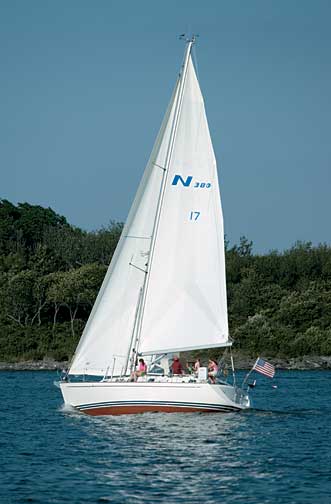 It's easy to overlook a boat's flaws when the weather is absolutely perfect and you're sailing on a summer breeze across a fairy-tale bay. Knowing that, the Najad 380 we test-sailed out of picturesque Dutch Harbor in Jamestown, Rhode Island, last July was given undue scrutiny. From its teak decks and sturdy rigging to its powerful 54-horsepower Yanmar diesel, state-of-the-art electronics, bow thrusters, sail-furling systems and hand-milled African mahogany cabinetry, every feature was examined with a diamond-cutter's eye.
It's easy to overlook a boat's flaws when the weather is absolutely perfect and you're sailing on a summer breeze across a fairy-tale bay. Knowing that, the Najad 380 we test-sailed out of picturesque Dutch Harbor in Jamestown, Rhode Island, last July was given undue scrutiny. From its teak decks and sturdy rigging to its powerful 54-horsepower Yanmar diesel, state-of-the-art electronics, bow thrusters, sail-furling systems and hand-milled African mahogany cabinetry, every feature was examined with a diamond-cutter's eye.
It was tough to find anything amiss. After all, the Najad 380 didn't just roll off the assembly line as another white fiberglass bleach bottle with high-tech sails. Its predecessor, the popular Najad 373, was designed to look good, sail comfortably and handle whatever weather might arise during an offshore passage. So it stands to reason that the next generation from Najad would be all those, and more.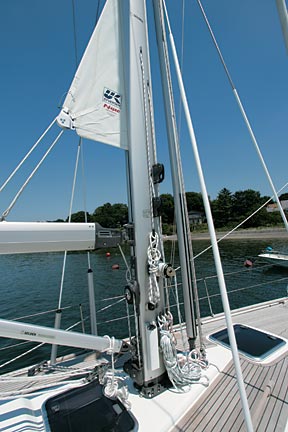 The thing that strikes you first upon stepping aboard is the sense that this boat has been overbuilt wherever possible. It shouts out heavy-duty cruiser. The fractional rig with twin spreaders and twin lower shrouds stabilize a Selden silver-anodized aluminum mast, which is stepped on the coachroof and supported below by a steel pillar. The model we sailed was customized with, among many features, in-mast furling. Stainless steel wire for the jib and main halyards was also tucked inside the mast. The backstay was mechanically adjustable, the boom fitted with a gas-dampened Selden rodkicker and topping lift.
The thing that strikes you first upon stepping aboard is the sense that this boat has been overbuilt wherever possible. It shouts out heavy-duty cruiser. The fractional rig with twin spreaders and twin lower shrouds stabilize a Selden silver-anodized aluminum mast, which is stepped on the coachroof and supported below by a steel pillar. The model we sailed was customized with, among many features, in-mast furling. Stainless steel wire for the jib and main halyards was also tucked inside the mast. The backstay was mechanically adjustable, the boom fitted with a gas-dampened Selden rodkicker and topping lift.
Deck fittings, including the chainplates bolted to transverse bulkheads, are stainless steel, and mooring cleats are through-bolted with backing pads. The hand-laid, epoxy-treated hull and foam-cored laminate deck are married with a fiberglass coating, the joint strengthened at the stanchion bases with through-hull mechanical fittings. At the bow, a chain locker with flush doors provides easy access to the power windlass for raising and lowering the hefty 35-pound Bruce anchor. 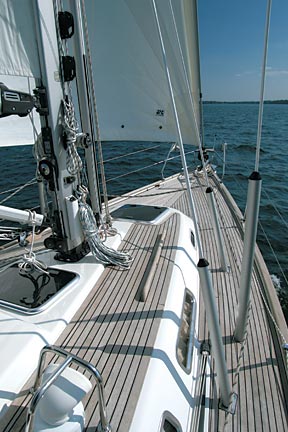
Alan Baines of Scandinavian Yachts in Newport, Rhode Island, and his 13-year-old son, Sam, joined me aboard Anthem as we sailed steadily in an 8-knot wind past the white-painted wooden lighthouse marking the entrance to Dutch Harbor on Jamestown's western shore. As soon as we cleared the spit of land that shapes the harbor, the wind gave us a lift.
It was clear from the start that the Najad 380 is a nimble boat, even in light air, despite its nine-ton displacement and solid construction. Tacking toward the Jamestown Bridge and Narragansett Bay certainly wasn't like driving a Lamborghini, but the 31-inch diameter, leather-covered wheel was easy to grip and ample enough to help guide the sloop through wide turns.
Although the halyards are tended at the base of the mast, the sheets lead to the cockpit where custom self-tailing Andersen power winches made tacking a no-brainer. On my shout of "hard alee," Sam gave the winch a couple of wraps. Changing course after that was, literally, a push of the button. 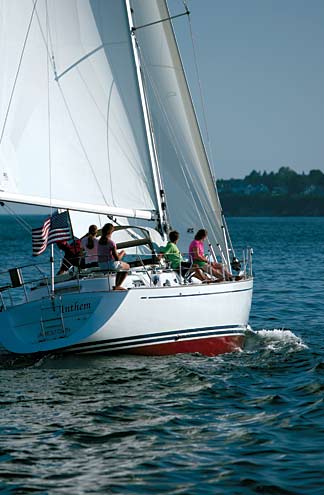 Sailing close to the wind as we rounded the channel island, the boat proved easy to point high, its tri-radial cut DC Mylar mainsail with vertical battens neat and trimmed, telltales fully extended on the 130-percent Genoa. With temperatures in the 90s, the bay was alive with white sails, many of them from nearby Newport.
Sailing close to the wind as we rounded the channel island, the boat proved easy to point high, its tri-radial cut DC Mylar mainsail with vertical battens neat and trimmed, telltales fully extended on the 130-percent Genoa. With temperatures in the 90s, the bay was alive with white sails, many of them from nearby Newport.
The wind remained light during most of our sail, but constant enough to keep the boat moving along at 5 knots. Off the wind only a few degrees, Anthem slipped into a happy slot that made her build speed. With the autopilot activated, there wasn't much more to do than enjoy the ride.
The spacious cockpit, sheltered by a windshield of toughened glass, was made to accommodate six, in addition to the helmsman's sculpted seat behind the wheel and two perches on the stern pulpit. It was an obviously well-thought-out design-a mix of sensibility, functionality and beauty, like just about everything else aboard this handcrafted yacht from Henan, Sweden.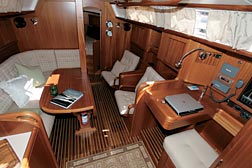 With the plotter and illuminated compass bolted to the steering pedestal and a row of gauges positioned just above the companionway, navigational information was never more than a glance away. A single red button, stenciled with the letters MOB, shared space with the other gauges, affixed to its own plate. It, too, was a customized option.
With the plotter and illuminated compass bolted to the steering pedestal and a row of gauges positioned just above the companionway, navigational information was never more than a glance away. A single red button, stenciled with the letters MOB, shared space with the other gauges, affixed to its own plate. It, too, was a customized option.
The throttle was simple and effective, as was the attached rocker switch that controls the optional, battery-operated bow thrusters. Leaving and returning to the dock to "parallel park" between two other boats was far less daunting knowing that the thrusters would compensate for any unwieldy current or wind gust.
Had the weather been cooler or wetter, we could have switched on the diesel heater and deployed the spray hood, which is affixed to the top of the hard windscreen. The spray hood can be extended over the entire cockpit. We also could have snapped on the side canvas curtains that completely enshroud the cockpit. The companionway's sliding hatch doubles as a chart table, handy when sailing from beneath the dodger. But instead of seeking shelter from the blistering sun, we reveled in the wind that caressed our faces as we sailed toward the old fortifications on Dutch Island, now a wildlife sanctuary.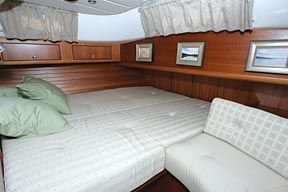 For those who prefer the creature comforts of home, the Najad 380 is no slacker. The company's motto is all about cruising beyond the horizon in style and comfort. Down below, there's plenty of standing headroom for sailors taller than 6 feet, 2 inches-grabrails are everywhere you'd want and expect them for safety, and whoever is doing the cooking won't be left out of the conversation. Although the layout of each Najad boat is built to order, the central living space and galley are made for socializing. Anthem's galley, just aft of the saloon on the port side, boasts a two-basin stainless steel sink with a mixed hot-cold faucet controlled by a foot pedal, 12-volt Waeco refrigerator, freezer, microwave, and gimbaled stove with oven and twin burners. The fixed gas pipes have a remote-controlled shutoff valve between the stove and gas canister. The angled countertop allows the cook to participate in the goings on aboard. Cupboards are plentiful and easy to reach, the shelves fitted with moveable pegs to keep glassware and other items from bouncing around.
For those who prefer the creature comforts of home, the Najad 380 is no slacker. The company's motto is all about cruising beyond the horizon in style and comfort. Down below, there's plenty of standing headroom for sailors taller than 6 feet, 2 inches-grabrails are everywhere you'd want and expect them for safety, and whoever is doing the cooking won't be left out of the conversation. Although the layout of each Najad boat is built to order, the central living space and galley are made for socializing. Anthem's galley, just aft of the saloon on the port side, boasts a two-basin stainless steel sink with a mixed hot-cold faucet controlled by a foot pedal, 12-volt Waeco refrigerator, freezer, microwave, and gimbaled stove with oven and twin burners. The fixed gas pipes have a remote-controlled shutoff valve between the stove and gas canister. The angled countertop allows the cook to participate in the goings on aboard. Cupboards are plentiful and easy to reach, the shelves fitted with moveable pegs to keep glassware and other items from bouncing around.
When it comes to serving meals, the dinette table leaves flip up and lock with no-fuss wooden brackets. Once again, the equipment is simple, practical, strong and handsome. The L-shaped upholstered settee on the port side provides abundant seating at the table, while two comfortable parlor chairs offer additional seating to starboard, as well as a civilized place to read a book after the sun goes down or watch the hideaway flat-screen television. The same dinette transforms into a fifth berth and a hidden compartment securely holds wine bottles, certainly a must aboard every cruising boat.
The aft cabin is spacious, its clean design lines in keeping with those so popular in Scandinavia. The V-berth stateroom is similarly fitted out. There's no shortage of stowage or wardrobe space, something lacking aboard many boats under 40 feet. Both cabins are warmly paneled in rich exotic woods but void of elaborate fittings, drawer handles and fanciful lighting. The affect is uncluttered and provides a sense of roominess. An opening skylight and two opening portals ventilate each cabin and allow daylight to spill inside.
The head, amidships on the starboard side just aft of the nav station, includes toilet, sink and shower all efficiently arranged, the washbasin and bench made from Corian for durability and easy cleansing. The head also features a wet locker and an opening portal.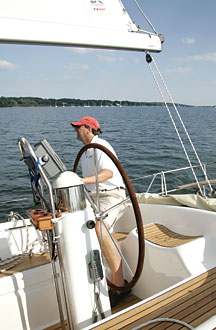 The well-planned nav station is a pure delight, not just an afterthought as is the case aboard many cruising vessels. A single designated seat allows the skipper or navigator to sit before a small table that can accommodate a folded chart and a notebook, its stow drawer ideal for safeguarding handheld GPS, wind gauge, VHF radio, dividers and parallel rules, pens and pencils. There's also room at the nav station to use the boat's primary VHF radio, tend to the circuit breaker panel that conveniently folds away, or read from a cruising guide or other reference book. Since the nav station is near the base of the companionway, whoever is navigating will be only steps away from the cockpit or helm. And though the primary function of the nav station is for plotting courses, the seat faces the saloon, allowing the navigator to socialize.
The well-planned nav station is a pure delight, not just an afterthought as is the case aboard many cruising vessels. A single designated seat allows the skipper or navigator to sit before a small table that can accommodate a folded chart and a notebook, its stow drawer ideal for safeguarding handheld GPS, wind gauge, VHF radio, dividers and parallel rules, pens and pencils. There's also room at the nav station to use the boat's primary VHF radio, tend to the circuit breaker panel that conveniently folds away, or read from a cruising guide or other reference book. Since the nav station is near the base of the companionway, whoever is navigating will be only steps away from the cockpit or helm. And though the primary function of the nav station is for plotting courses, the seat faces the saloon, allowing the navigator to socialize.
The companionway steps can be removed to service the engine. Another hinged door in the passageway aft of the galley provides additional access to the sound-insulated engine room, so there's no struggle to check the filters and fluids.
Below the waterline, a design by Hamburg, Germany-based Judel/Vrolijk and the Najad in-house staff combines a spade rudder with a bolted-on lead keel, the latter sporting an elongated foot to accommodate a bulbous edge intended to keep the center of gravity low. According to Baines, the configuration reduces the water flow beneath the keel, which optimizes the boat for less drag.
The standard Najad 380 draws 6 feet, 3 inches, although an alternative model offers a 5-foot, 4-inch draft. The boat's proportions are traditional in that they don't exceed the 3-to-1 ratio of length to width. Her overall length at 37 feet, 9 inches (32 feet, 5 inches at the waterline), matched to her 12-foot beam, give the boat a sleek appearance that turns heads. Designed more as a cruiser than racer, the Najad 380's capabilities are more likely to shine during an offshore passage than around the buoys.
After putting Anthem through her paces for a few hours and enjoying the intense sun, time came to head for the mooring back in Dutch Harbor. We looped our pennant on the bow cleat and made fast work of the UK-Halsey sails. The foresail retreated with help from its Selden Furlex roller-furling drum, while the main rolled neatly inside the mast. Done. No sail covers to fuss over, no sail ties to knot.
Had we the inclination, the stern swim platform was an inviting place from which to dive into New England's summertime sea. Instead, we secured the dropboards to the companionway and downed an ice-cold beer while waiting for the launch-a fitting end to another day on the water, made special because it was aboard a Najad.

Comments